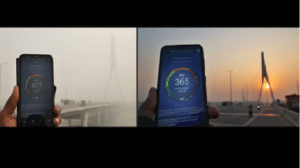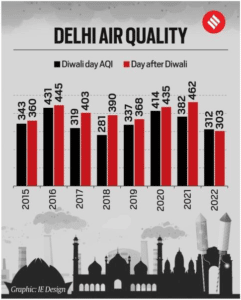Delhi sees cleanest day-after-Diwali air since 2015
Why in News?
The AQI on Diwali day this year is the cleanest that the city has seen since 2019.
Comparison of pollution level post Diwali in 2021 (left) and 2022 (right); both photos are taken at the Signature Bridge.
This year, the day after Diwali has seen the cleanest air in Delhi since 2015. This, despite the AQI remaining in the ‘very poor’ category on both Diwali and the day after, with pollution levels recording a surge when firecrackers were set off in violation of Delhi government’s ban.
The AQI (air quality index) on Diwali day was 312, while it was 303 on Tuesday, according to data from the Central Pollution Control Board (CPCB). AQI between 301 and 400 is considered to be ‘very poor’. The AQI on Diwali day this year is the cleanest that the city has seen since 2019.
Reasons for reduced pollution:
- Meteorological conditions played a role in the improved air quality this time.
- “It appears that there may have been a reduction in firecracker emissions compared to last year. The air quality did not deteriorate as much as it could have.
- The contribution of crop residue burning in Punjab and Haryana has also been low so far this year.
- The wind direction, which has been from the westerly-southwesterly direction of Delhi since Monday, has not been favourable to transport stubble burning smoke from the northwest, Beig explained.
- According to an update issued by the SAFAR forecasting system, the share of stubble burning to PM2.5 levels in Delhi was around 5.6% on Tuesday. In contrast, the contribution of stubble burning to Delhi’s air on Diwali day (November 4) last year was 25%, and 36% on the day after Diwali, according to data from SAFAR.
- “Some control measures may have worked. It may be that people opted for firecrackers which release fewer toxic fumes though they produce sound,” Beig added.





